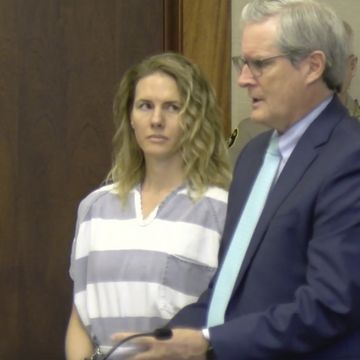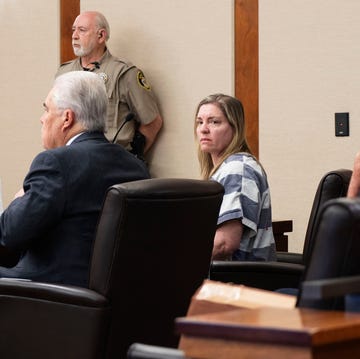This story is a collaboration with PopularMechanics.com
Traitors? Martyrs? Just what were the Rosenbergs? After more than 70 years, we might finally have found out.
Like Benedict Arnold, Wyatt Earp, or Davy Crockett before them, the names Julius and Ethel Rosenberg have become something beyond mere monikers once attached to two people who lived and died in the United States. “The Rosenbergs” has become a form of shorthand, a symbol within the shared American vernacular. But whether that name is shorthand for “traitor” or “martyr” is not agreed upon today. In fact, it was hardly agreed upon even when they were alive.
A seemingly-unassuming Jewish couple from New York City charged with conspiracy to commit espionage in 1951, the saga of the Rosenbergs became a referendum on national security and Soviet infiltration as well as American attitudes on anti-Communism and anti-Semitism.
On one end of the spectrum, FBI Director J. Edgar Hoover called their alleged actions “the crime of the century,” evoking a label previously applied to an earlier headline-grabbing story with a tinge of xenophobia: the Lindbergh Baby kidnapping. While the Rosenbergs weren’t suspected of stealing and killing the child of an American icon as Bruno Hauptmann had been, the charges were gravely serious: organizing and operating a ring of spies on behalf of the Soviet Union by infiltrating American science and engineering all the way up to the famed Manhattan Project at Los Alamos. “I consider your crimes worse than murder,” the judge overseeing the case later declared.
For all the gravity of the charges, the evidence presented to the public at the time was specious at best. To those outside the confines of the courtroom, their convictions appeared to be a case of Cold War paranoia run amok. The French philosopher Jean-Paul Sartre declared the prosecution of the Rosenbergs “a legal lynching which smears with blood a whole nation.”
Less than a decade prior, Sartre had published his famed essay Réflexions sur la question juive (published in English as either Reflections on the Jewish Question or Anti-Semite and Jew) in the aftermath of the Liberation of Paris during World War II. He was far from the only one to suggest that the impending execution of the allegedly traitorous Rosenbergs was rooted not in proof but in prejudice. Civil rights activist W.E.B. Du Bois, who had himself faced accusations of acting on behalf of a foreign government in 1951 during United States v. Peace Information Center, declared in condemnation: “Crucify us, Vengeance of God, as we crucify two more Jews.”
Julius and Ethel Rosenberg were convicted on March 29, 1951, and executed on June 19, 1953. But the question of their possible innocence, rather than following them to their graves, has endured for more than half a century since. The two sons they left behind maintained both of their parents’ innocence for decades, while artists ranging from Bob Dylan to Pulitzer Prize-winning playwright Tony Kushner evoked the Rosenbergs as American martyrs in their works.
But things began to change in 1995, after the collapse of the Soviet Union and the subsequent declassification of Cold War documents showed that the former superpower had more tendrils extended into the inner-workings of the United States than mid-century America had been led to believe at the time. Since then, the slow drip of declassified documents, all the way up to the final months of 2024, have chipped away at the narratives that had been shaped in the aftermath of the executions and have recast the saga of the Rosenbergs into a matter of who knew what and when.
The Origins of the Rosenberg Spy Ring
In 1936, Ethel Greenglass and Julius Rosenberg met at a gathering of the Young Communist Organization USA in New York City. Julius, an electrical engineering student, had taken an active role within the organization, while Ethel, whose original dreams of stardom as a singer were dashed by the Great Depression, had fallen in with the growing American labor movement during a strike in New York’s garment district where she had taken work as a typist. The couple were married in 1939.
The following year, Julius found work as an engineer-inspector at the Army Signal Corps Engineering Laboratories in New Jersey. By 1942, both the Soviet Union and the United States had entered the maelstrom of World War II, and from his post in Fort Monmouth, Julius was serving both nations.
As recounted decades later by Julius’ handler Aleksandr Feklisov in his 2001 memoir The Man Behind the Rosenbergs, Julius had first been approached by Soviet recruiter Semyon Markovich Semyonov at a Labor Day rally on September 7, 1942. “As a seasoned recruiter, Semyonov didn’t want to push things too far too quickly,” Feklisov writes, “but Julius’ enthusiasm towards the Soviet Union was so friendly and sincere that he decided to make his pitch at the third meeting.” When Semyonov suggested to Rosenberg that the United States was hiding its latest technological and military innovations from the USSR, who “needed them very badly,” Feklisov records Rosenberg’s response as having been “If I can do anything to help, you can count on me.”
Julius’ help extended beyond his own prodigious acquisition of confidential documents.“His usual delivery was between six hundred and one thousand pages long” writes Feklisov. He also acted as a recruiter for other spies. As Felisov notes: “Rosenberg was not just a very valuable source himself; he was also the linchpin of a network growing in importance from month to month.”
Rosenberg’s ring of spies included his former classmate Morton Sobell, an electrical engineer with government contracts, and his brother-in-law David Greenglass, who worked in Los Alamos on the famed Manhattan Project, the research and development program behind the atomic bomb. But while these recruitments made Julius, given the code names “Antenna” and “Liberal” by his Soviet handlers, an extremely valuable asset to the USSR, they also ultimately led to his downfall.
On February 2, 1950, Los Alamos physicist Klaus Fuchs was arrested for violations of the Official Secrets Act. Although Fuchs was not a member of the spy ring that Julius had assembled, the two shared the same Soviet intermediary, a courier named Harry Gold. And that wasn’t the only thing the scientists had in common. Unbeknownst to them, and to their Soviet handlers, Fuchs and Rosenberg were both already well-ensnared in a counter-espionage web that wasn’t exposed until after the nation they spied for had collapsed into the dustbin of history: the Venona Project.
The Venona Project
Under the oversight of the U.S. Army’s Signal Intelligence Service, and later the National Security Agency, the Venona Project was active from 1943 to 1980. The Commission on Government Secrecy finally forced it into the light in 1995, reshaping how historians understood the American “Red Scare” of the mid-20th century.
The Soviets had been using what should have been a foolproof encryption method: a one-time pad technique. As defined in the NSA’s now-declassified 1973 text A History of U.S. Communications Security: “One-time pads are pure and simple cipher systems (not codes); with a one for one replacement of each plaintext character by a cipher equivalent. They consist of page after page of random numbers or letters.” The encryption was, therefore, unbreakable, because each key was used only a single time.
Or at least, that’s how it was supposed to be.
In reality, the pressures of WWII forced the Soviets to double-up their use of some key number pages, which provided the opening the SIS needed to secretly intercept and decode Soviet messages. These decrypted communications revealed the intricate network of spies the Soviet Union had infiltrating the United States through industry, the military, and even high positions in the U.S. government, including the at-the-time highly controversial case of Alger Hiss. Klaus Fuchs appeared in Venona-decrypted messages, as did intermediary Harry Gold. And Julius Rosenberg can be found amongst the over 3,000 pages of Venona Project documents, usually under his codename Antenna, while his wife Ethel appears in one message under her given name.
But while the SIS had spies like Rosenberg dead to rights in the correspondence they intercepted, they couldn’t actually share the information they had gathered, lest it expose the Venona Project and tip off the Soviets to the fact that their “foolproof” encryption had been cracked.
This left the United States government in a position of having to prosecute cases against individuals they knew were spies without being able to actually admit what they knew. It meant a campaign of intimidation and intimation, where caught spies were pressured into rolling over on others, pushed into “naming names” that the SIS already had within their Venona files. To a portion of the public, this looked like dogged persecution in the absence of any real evidence, implicating the innocent in order to force confessions from those presumed guilty.
It is, in fact, possible that such a tactic was deployed in the case of the Rosenbergs, with the government only charging Ethel—on whom they had no direct evidence of wrongdoing—in the hopes that her husband would confess in order to save her. But if that were the plan, it was one which backfired with horrific consequences.
Pressure had been applied to Fuchs to turn on Gold. Pressure was then applied to Gold to turn on David Greenglass, Ethel’s brother. The testimonies of Gold and Greenglass were then relied upon to prosecute Julius and Ethel Rosenberg. While the testimonies largely matched what the government knew about Julius’ activities through the Venona Project, Biography previously noted that “to this point, the government’s case against Ethel was largely nonexistent.” While Ethel likely knew about her husband’s activities, they didn’t have any records indicating she herself participated in any acts of espionage.
Perhaps, given the reliance on pressure campaigns, the government had hoped the possibility of Ethel being put to death despite her innocence would force a confession from Julius to spare his spouse the proverbial hangman’s noose. However, both Julius and Ethel held firm, denying the charges against them and otherwise exercising their fifth amendment right to remain silent.
However, the same could not be said for Greenglass. When questioned on the matter of who typed out his handwritten notes before they were handed off to the Soviets, Greenglass tried to spare his then-suspected wife, Ruth, and claimed his sister, Ethel, had been the one to do the typing. On this, the prosecution pounced.
As Biography noted before, “Chief prosecutor Irving H. Saypol leaped all over this account, dramatically telling the jury how she ‘sat at that typewriter and struck the keys, blow by blow, against her own country in the interests of the Soviets.’” They were found guilty, and Judge Irving R. Kaufman imposed the death penalty on both Julius and Ethel. They were executed at Sing Sing Prison in New York on June 19, 1953, via electric chair.
To the public, it appeared that two Americans were sentenced to death on little more than he said-she said testimony. To the government officials with access to the Venona Project files, they knew that wasn’t true—but only for Julius. None of the over 3,000 Venona Project documents that have been released to the public have indicated Ethel was directly involved in Julius’ work, though she was likely aware of it.
The Rosenbergs’ children, Michael and Robert Meeropol, long maintained the innocence of their parents. In 2008, after the Venona Project was declassified and electrical engineer Martin Sobell publicly confessed to he and Julius’ betrayal while maintaining Ethel’s innocence, the two sons focused on exonerating their mother in the public eye.
New Information Exonerates Ethel Rosenberg?
That endeavor added a new, and possibly final, chapter in late 2024. According to the Associated Press, this past September, the brothers presented the media outlet with a newly declassified, previously undisclosed memo which they feel is “a smoking gun” on the matter of Ethel’s innocence. As the Associated Press reported:
“The handwritten memo from Meredith Gardner, a linguist and codebreaker for what later became known as the National Security Agency, cites decrypted Soviet communications in concluding that Ethel Rosenberg knew about Julius’ espionage work ‘but that due to ill health she did not engage in the work herself.’”
The sons had hoped this new revelation (which AP notes is still not enough to convince some scholars of Ethel’s total innocence) would have compelled President Joe Biden to use his final days in office to grant a posthumous pardon for Ethel. Now, that possibility is in the hands of President Donald Trump, who in a strange twist of fate has a connection to the Rosenbergs: Trump’s oft-cited mentor, lawyer Roy Cohn, was one of the prosecutors in the Rosenbergs’ trial.
Cohn’s connection to the death of Ethel Rosenberg was immortalized in Tony Kushner’s Pulitzer Prize–winning 1991 play Angels in America, where Ethel’s ghost haunts a dying Cohn in 1980s New York. “And you could kill me…” her spirit tells Cohn in one of the play’s more stirring moments, “...but you couldn’t ever defeat me... you never won.”
Michale Natale is a News Editor for the Hearst Enthusiast Group. As a writer and researcher, he has produced written and audio-visual content for more than fifteen years, spanning historical periods from the dawn of early man to the Golden Age of Hollywood. His stories for the Enthusiast Group have involved coordinating with organizations like the National Parks Service and the Secret Service, and travelling to notable historical sites and archaeological digs, from excavations of America’ earliest colonies to the former homes of Edgar Allan Poe.



















